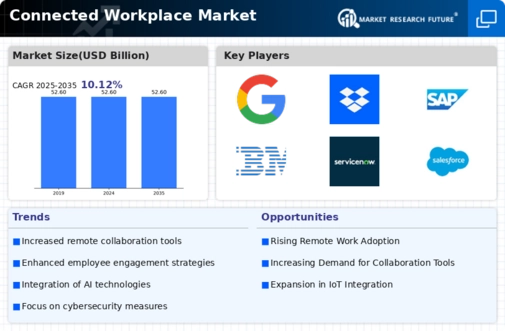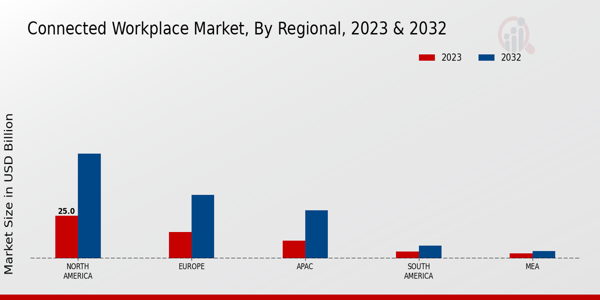Rise of Remote Work
The rise of remote work is a defining characteristic of the Connected Workplace Market, reshaping how organizations operate. As businesses adapt to this new normal, they are investing in technologies that facilitate remote collaboration and communication. This trend has led to a surge in demand for cloud-based solutions and virtual collaboration tools. Data suggests that companies embracing remote work models can save up to 30% on operational costs, as they require less physical office space. Additionally, remote work has been linked to increased employee productivity, with many workers reporting higher job satisfaction. This shift not only reflects changing employee preferences but also indicates a broader transformation in workplace dynamics, making it a significant driver in the Connected Workplace Market.
Sustainability Initiatives
Sustainability initiatives are increasingly influencing the Connected Workplace Market as organizations strive to reduce their environmental footprint. Companies are adopting eco-friendly practices, such as remote work policies and energy-efficient office designs, to promote sustainability. This shift is not merely a trend; it is becoming a strategic imperative. Research shows that 70% of employees prefer to work for companies that prioritize sustainability. Furthermore, organizations that implement green technologies, such as energy-efficient lighting and smart HVAC systems, can reduce operational costs by up to 20%. This commitment to sustainability not only enhances corporate reputation but also aligns with the values of a socially conscious workforce, making it a critical driver in the Connected Workplace Market.
Focus on Employee Well-being
In the Connected Workplace Market, there is an increasing emphasis on employee well-being, which encompasses mental health, work-life balance, and overall job satisfaction. Companies are recognizing that a healthy workforce is crucial for productivity and retention. As a result, many organizations are implementing wellness programs and flexible work arrangements to support their employees. Data indicates that businesses prioritizing employee well-being experience a 25% reduction in turnover rates. Additionally, the integration of wellness technologies, such as mental health apps and virtual fitness programs, is becoming commonplace. These initiatives not only enhance employee morale but also foster a positive workplace culture, which is essential for attracting top talent in the competitive job market.
Enhanced Cybersecurity Measures
As the Connected Workplace Market evolves, the importance of enhanced cybersecurity measures cannot be overstated. With the rise of remote work and digital collaboration, organizations face increased risks of cyber threats. Consequently, businesses are investing heavily in robust cybersecurity frameworks to protect sensitive data and maintain operational integrity. Recent statistics reveal that cyberattacks have increased by 40% in the past year, prompting companies to prioritize cybersecurity as a fundamental aspect of their operational strategy. This includes implementing advanced encryption technologies, multi-factor authentication, and employee training programs to mitigate risks. By fostering a secure digital environment, organizations not only protect their assets but also build trust with employees and clients, making cybersecurity a crucial driver in the Connected Workplace Market.
Integration of Advanced Technologies
The Connected Workplace Market is experiencing a notable shift due to the integration of advanced technologies such as artificial intelligence, machine learning, and the Internet of Things. These technologies facilitate seamless communication and collaboration among employees, regardless of their physical location. For instance, AI-driven tools can analyze employee productivity and suggest improvements, thereby enhancing overall efficiency. According to recent data, organizations that adopt these technologies report a 30% increase in operational efficiency. Furthermore, the rise of smart office solutions, which utilize IoT devices to optimize workspace utilization, is transforming traditional office environments into dynamic, responsive workplaces. This trend not only boosts employee satisfaction but also contributes to cost savings, making it a pivotal driver in the Connected Workplace Market.


















Leave a Comment